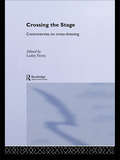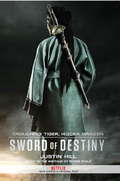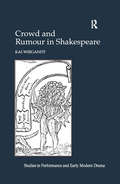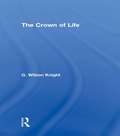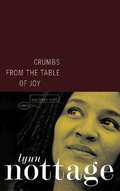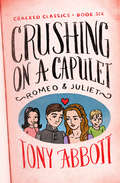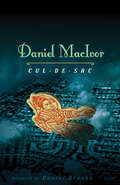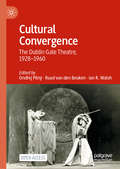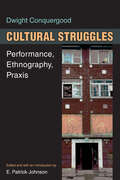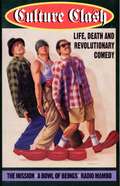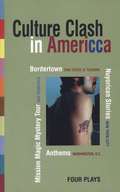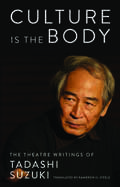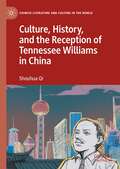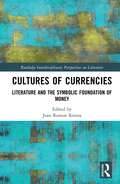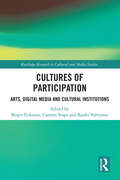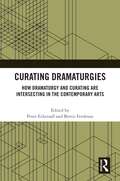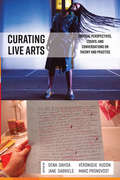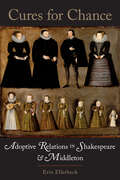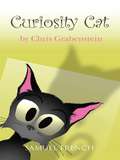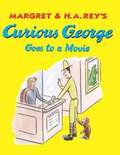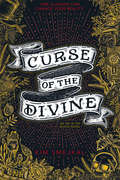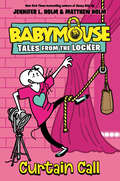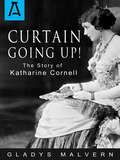- Table View
- List View
Crossing the Stage: Controversies on Cross-Dressing
by Lesley FerrisCrossing the Stage brings together for the first time essays which explore cross-dressing in theatre, cabaret, opera and dance. The volume contains seminal pieces which have become standard texts in the field, as well as new work especially commissioned from leading writers on performance.Crossing the Stage is an indispensable sourcebook on theatrical cross-dressing. It will be essential reading for all those interested in performance and the representation of gender.
Crouching Tiger Hidden Dragon - Sword Of Destiny
by Justin Hill Wang DuluAnother life-altering quest, another struggle between honor and lust for power, another generation of warriors forging alliances and enmities. <P><P> The adventure, romance, and artistry of Crouching Tiger, Hidden Dragon continues in this novelized companion to the first ever Netflix debut film, Crouching Tiger, Hidden Dragon: Sword of Destiny based on the novel by Wang Dulu. Seventeen years after the legendary fighter Mubai dies protecting the world-conquering sword The Green Destiny, four great warriors are called together to guard the formidable weapon once more. The forces surrounding the sword irrevocably altered the life of Shulien, Mubai's lover, but seventeen years later she is still honor-bound to defend the blade from the power-hungry warlord Hades Dai. The young fighters Wei-fang and Snow Vase, switched at birth, also have heritages and inheritances that inextricably link them to both each other and the fate of the sword. And Silent Wolf, Shulien's former fiancé, returns from presumed death to thwart Hades Dai--and rekindle an emotionally isolated Shulien's feelings. Jam-packed with all the hallmarks of an epic adventure--sacrifice, battles, betrayal, vengeance, redemption, and destiny--this saga also explores the deeper meaning of true heroism and virtue. As Wei-fang and Snow Vase search for identity and forge their places in the world of warriors and heroes, Shu-lien and Silent Wolf struggle to reconcile both the traditions and heartbreak of the past with a fragile hope for the future.
Crowd Funding for Filmmakers: The Way to a Successful Film Campaign
by John T. TrigonisThis book offers practical information, tips, and tactics for launching a successful film campaign by detailing traditional models of fundraising, utilizing today’s technological and social innovations, and augmenting each step with an added personal touch. This 2nd edition updates the latest techniques on Social Media to get your projects up and running asap.
Crowd and Rumour in Shakespeare (Studies in Performance and Early Modern Drama)
by Kai WiegandtIn this study, the author offers new interpretations of Shakespeare's works in the context of two major contemporary notions of collectivity: the crowd and rumour. The plays illustrate that rumour and crowd are mutually dependent; they also betray a fascination with the fact that crowd and rumour make individuality disappear. Shakespeare dramatizes these mechanisms, relating the crowd to class conflict, to rhetoric, to the theatre and to the organization of the state; and linking rumour to fear, to fame and to philosophical doubt. Paying attention to all levels of collectivity, Wiegandt emphasizes the close relationship between the crowd onstage and the Elizabethan audience. He argues that there was a significant - and sometimes precarious - metatheatrical blurring between the crowd on the stage and the crowd around the stage in performances of crowd scenes. The book's focus on crowd and rumour provides fresh insights on the central problems of some of Shakespeare's most contentiously debated plays, and offers an alternative to the dominant tradition of celebrating Shakespeare as the origin of modern individualism.
Crown Of Life - Wilson Knight: Essays In Interpretation Of Shakespeare's Final Plays (University Paperbacks Ser.)
by G. Wilson KnightFirst published in 2002. Routledge is an imprint of Taylor & Francis, an informa company.
Crumbs from the Table of Joy and Other Plays
by Lynn NottageThis collection includes Lynn Nottage's best known work, Crumbs from the Table of Joy, which has been produced widely since its premiere in May 1995 and which the Chicago Tribune hailed as "a complex and thought provoking new play." Also included are Mud, River, Stone, Poof, Por'Knockers and her latest work, Las Meninas, inspired by the playwright's research into the African presence in 17th century Europe.Lynn Nottage lives in Brooklyn, New York. Her plays have been produced in many theatres across the U.S. including Second Stage (NY), South Coast Rep (Costa Mesa), Yale Repertory Theatre (New Haven), Alliance Theatre (Atlanta) and Steppenwolf (Chicago). She has won the Heideman and the White Bird awards and was a runner-up for the Susan Blackburn award.
Crushing on a Capulet: (Romeo & Juliet) (Cracked Classics #6)
by Tony AbbottSixth graders Devin and Frankie try to save star-crossed lovers Romeo and Juliet when they&’re magically transported into Shakespeare&’s classic play. When their teacher assigns Devin and Frankie—short for Francine—the lead roles in their class production of Romeo and Juliet, the two best friends aren&’t thrilled. How are they supposed to say their lines when they don&’t even sound like they were written in English? Luckily, the library&’s magic security gates come to their rescue again, and they leap into Shakespeare&’s famous tragedy. Unfortunately, they land right in the middle of a sword fight between two warring families, the Montagues and the Capulets. When they find out that Romeo Montague has fallen in love with Juliet Capulet, Devin and Frankie decide it&’s up to them to make sure this unlikely couple lives happily ever after. But can they change the book&’s tragic end and save the young lovers from their fate? &“The message that reading is important and can be fun comes through loud and clear,&” writes School Library Journal about the Cracked Classics series. &“The short chapters make this an ideal read-aloud and a treat for reluctant readers.&”
Cue Tears: On the Act of Crying
by Daniel SackCrying holds a privileged place in conversations around emotions as an expression of authentic feeling. And yet, tears are ambiguous: they might signal the most positive and negative of affects; they might present a sincere revelation of self or be simulated to manipulate others. Unsurprisingly, tears figure prominently on stage and on screen, where actors have experimented with the mechanics of making tears. Cue Tears: On the Act of Crying uses tears as a prism through which to see some of the foundational problems and paradoxes of acting and spectatorship anew, including matters of authenticity and sincerity, the ethics of the witness, the interaction between a speech act and its affective force, liveness and documentation. Across seven semi-autonomous essays, Cue Tears looks at the mechanisms of tear production, internal and external techniques that actors use to weep, and the effects of tears in performance situations on the stage, in the gallery, and in the classroom. The writing moves with a light touch between theory and criticism of a broad range of instances from literature, theater, performance art, visual art, and cinema, while also embracing a strong autobiographical and personal slant. Author Daniel Sack’s father was a biochemist who studied tears and collected his son’s tears for research during his childhood. These “reflex tears” were produced as a physical response to irritation—an eye stretched past the point of blinking, a cotton swab up the nose. This childhood occupation coincided with his first years taking acting classes, trying to learn how to cry “emotional tears” onstage through psychological stimulation and the recollection of memory. Cue Tears investigates these memories and methods, finding that tears both shore up and dissolve distinctions between truth and artifice, emotional and physical, private and public, sad and humorous.
Cul-de-sac
by Daniel Brooks Daniel MacivorIn his latest collaboration with director Daniel Brooks, MacIvor plays the role of Leonard, who narrates the events leading up to his murder while trying to understand them himself. Through the course of the play, we peer behind the curtains of his neighbourhood as MacIvor transforms into the multiple characters who bear witness to Leonard's life and death.
Cultural Convergence: The Dublin Gate Theatre, 1928–1960
by Ondřej Pilný Ian R. Walsh Ruud van den BeukenBased on extensive archival research, this open access book examines the poetics and politics of the Dublin Gate Theatre (est. 1928) over the first three decades of its existence, discussing some of its remarkable productions in the comparative contexts of avant-garde theatre, Hollywood cinema, popular culture, and the development of Irish-language theatre, respectively. The overarching objective is to consider the output of the Gate in terms of cultural convergence – the dynamics of exchange, interaction, and acculturation that reveal the workings of transnational infrastructures.
Cultural Struggles: Performance, Ethnography, Praxis
by E. Patrick Johnson Dwight ConquergoodThe late Dwight Conquergood's research has inspired an entire generation of scholars invested in performance as a meaningful paradigm to understand human interaction, especially between structures of power and the disenfranchised. Conquergood's research laid the groundwork for others to engage issues of ethics in ethnographic research, performance as a meaningful paradigm for ethnography, and case studies that demonstrated the dissolution of theory/practice binaries.Cultural Struggles is the first gathering of Conquergood's work in a single volume, tracing the evolution of one scholar's thinking across a career of scholarship, teaching, and activism, and also the first collection of its kind to bring together theory, method, and complete case studies. The collection begins with an illuminating introduction by E. Patrick Johnson and ends with commentary by other scholars (Micaela di Leonardo, Judith Hamera, Shannon Jackson, D. Soyini Madison, Lisa Merrill, Della Pollock, and Joseph Roach), engaging aspects of Conquergood's work and providing insight into how that work has withstood the test of time, as scholars still draw on his research to inform their current interests and methods.
Culture Clash
by Culture ClashThis three-person troupe is unique not only for its imaginative explorations of contemporary Latin/Chicano culture but also for its vision of a society in transition.
Culture Clash in AmeriCCa
by Culture Clash"These guys are funny daredevils of performance, totally fearless as they skewer convention and lazy thinking. Cool."--Eric Bogosian"Important social satire for these urgent times."--Dolores Huerta, Vice President, United Farm Workers Union"Keep kicking them in the cojones."--George CarlinThe newest work by the ever-outrageous comic trio, Culture Clash (Richard Montoya, Ric Salinas, and Herbert Siguenza) collects their four most recent investigations into contemporary American culture as viewed in four very distinct American cities. Each piece was commissioned by a local theatre company who invited our three lads into their communities and unlocked the doors. This volume includes:* "Bordertown" examinines the twin border cities of San Diego and Tijuana with special guest appearances by Charleton Heston, Shamu the Killer Whale, and Sidewinder Sam. * "Nuyorican Stories" brings the Clash to the Big Apple as they delve into the personal histories of the early Puerto Rican political activists in New York. * "Mission Magic Mystery Tour" is Culture Clash's return to their home turf of San Francisco's Mission District as the locals withstand an all-out invasion by the dot-com generation. *"Dreaming of Lincoln" brings the fearless troupe to our nation's capital for a unique look at the land of the free.Culture Clash formed in 1984 to fill a unique role in American arts. Their nominal mission is to show cultures in opposition and, by opposing them, bring them closer together. But their talents are too expansive to be restricted to just "political theatre." Culture Clash have managed to gerrymander theatre's traditional map, erasing the borders between any and all districts they choose to explore. They have a style all their own with a foundation that harkens back to the best vaudevillians of the U.S. and Latin America. Comedy and satire is what they feed on, in the tradition of Lenny Bruce, the Marx Brothers, Charlie Chaplin, and Catinflas.
Culture is the Body
by Tadashi Suzuki Kameron Steele"Mr. Suzuki's art seeks to reach audiences not through the intellect but through the senses and instincts."--New York Times"In my opinion, a 'cultured' society is one where the perceptive and expressive abilities of the human body are used to the full; where they provide the basic means of communication."--Tadashi SuzukiRenowned for his actor training methods, Tadashi Suzuki provides a thorough and accessible formulation of his ideas and beliefs in this new edition of his theater writings. One of the world's most revered theater directors, Suzuki is also a seminal thinker and practitioner whose work has had a profound influence on theater worldwide. This landmark collection provides a useful, provocative look at his philosophical and practical approaches to the stage. Culture is the Body is a complete revision of Suzuki's influential book The Way of Acting, featuring new essays and in a revised translation by Kameron Steele, a longtime collaborator of Suzuki's.Legendary theater director Tadashi Suzuki explains his revered approach in this new edition of his writings.Tadashi Suzuki is the founder and director of the Suzuki Company of Toga (SCOT), the organizer of Japan's first international theater festival (Toga Festival), and the creator of the Suzuki Method of Actor Training. Suzuki has articulated his theories in a number of books. He has taught his system of actor training in schools and theaters throughout the world. Besides productions with his own company, he has directed several international collaborations.
Culture, History, and the Reception of Tennessee Williams in China (Chinese Literature and Culture in the World)
by Shouhua QiThis book is the first comprehensive study of the reception of Tennessee Williams in China, from rejection and/or misgivings to cautious curiosity and to full-throated acceptance, in the context of profound changes in China’s socioeconomic and cultural life and mores since the end of the Cultural Revolution. It fills a conspicuous gap in scholarship in the reception of one of the greatest American playwrights and joins book-length studies of Chinese reception of Shakespeare, Ibsen, O’Neill, Brecht, and other important Western playwrights whose works have been eagerly embraced and appropriated and have had catalytic impact on modern Chinese cultural life.
Cultures of Currencies: Literature and the Symbolic Foundation of Money (Routledge Interdisciplinary Perspectives on Literature)
by Joan Ramon ResinaThis book’s premise is not only the commonly accepted cultural relativity of economic concepts, but also the observation that the current shift in the meaning of concepts like “market,” “currency,” “exchange,” and “money” suggests that culture is undergoing a change with unpredictable economic and political consequences. The essays in the book raise basic questions concerning exchange – what is exchanged, who exchanges and how, which kind of currency is used, and indeed what is money and how does it convey and retain value over time. These issues are all classical objects of economic theory, but less often have they been approached from a cultural perspective. Works treating economic and monetary issues from a cultural perspective are few and far apart, and this book aims to contribute to such a perspective with a variety of approaches.
Cultures of Participation: Arts, Digital Media and Cultural Institutions (Routledge Research in Cultural and Media Studies)
by Carsten Stage Birgit Eriksson Bjarki ValtyssonThis book examines cultural participation from three different, but interrelated perspectives: participatory art and aesthetics; participatory digital media, and participatory cultural policies and institutions. Focusing on how ideals and practices relating to cultural participation express and (re)produce different "cultures of participation", an interdisciplinary team of authors demonstrate how the areas of arts, digital media, and cultural policy and institutions are shaped by different but interrelated contextual backgrounds. Chapters offer a variety of perspectives and strategies for empirically identifying "cultures of participation" and their current transformations and tensions in various regional and national settings. This book will be of interest to academics and cultural leaders in the areas of museum studies, media and communications, arts, arts education, cultural studies, curatorial studies and digital studies. It will also be relevant for cultural workers, artists and policy makers interested in the participatory agenda in art, digital media and cultural institutions.
Curating Dramaturgies: How Dramaturgy and Curatorial Practices are Intersecting in the Contemporary Arts
by Peter Eckersall Bertie FerdmanCurating Dramaturgies investigates the transformation of art and performance and its impact on dramaturgy and curatorship. Addressing contexts and processes of the performing arts as interconnecting with visual arts, this book features interviews with leading curators, dramaturgs and programmers who are at the forefront of working in, with, and negotiating the daily practice of interdisciplinary live arts. The book offers a view of praxis that combines perspectives on theory and practice and looks at the way that various arts institutions, practitioners and cultural agents have been working to change the way that art and performance have developed and experienced by spectators in the last decade. Curating Dramaturgies argues that cultural producers and scholars are becoming more cognizant of this overlapping and transforming field. The introductory essay by the editors explores the rise of interdisciplinary live arts and its ramifications in cultural and political terms. This is further elaborated in the interviews with 15 diversely placed arts professionals who are at the forefront of rethinking and consolidatingthe ever-evolving field of the visual arts and performance.
Curating Live Arts: Critical Perspectives, Essays, and Conversations on Theory and Practice
by Dena Davida Marc Pronovost Véronique Hudon Jane GabrielsSituated at the crossroads of performance practice, museology, and cultural studies, live arts curation has grown in recent years to become a vibrant interdisciplinary project and a genuine global phenomenon. Curating Live Arts brings together bold and innovative essays from an international group of theorist-practitioners to pose vital questions, propose future visions, and survey the landscape of this rapidly evolving discipline. Reflecting the field’s characteristic eclecticism, the writings assembled here offer practical and insightful investigations into the curation of theatre, dance, sound art, music, and other performance forms—not only in museums, but in community, site-specific, and time-based contexts, placing it at the forefront of contemporary dialogue and discourse.
Cures for Chance: Adoptive Relations in Shakespeare and Middleton
by Erin EllerbeckAdoption allows families to modify, either overtly or covertly, what is considered to be the natural order. Cures for Chance explores how early modern English theatre questioned the inevitability of the biological family and proposed new models of familial structure, financial inheritance, and gendered familial authority. Because the practice of adoption circumvents sexual reproduction, its portrayal obliges audiences to reconsider ideas of nature and kinship. This study elucidates the ways in which adoptive familial relations were defined, described, and envisioned on stage, particularly in the works of Shakespeare and Middleton. In the plays in question, families and individual characters create, alter, and manage familial relations. Throughout Cures for Chance, adoption is considered in the broader socioeconomic and political climate of the period. Literary works and a wide range of other early modern texts – including treatises on horticulture and natural history and household and conduct manuals – are analysed in their historical and cultural contexts. Erin Ellerbeck argues that dramatic representations of adoption test conventional notions of family by rendering the family unit a social construction rather than a biological certainty, and that in doing so, they evoke the alteration of nature by human hands that was already pervasive at the time.
Curiosity Cat
by Chris GrabensteinTheatre for Young AudiencesCharacters: 6 males, 4 females, 6 males or females, plus extras"To my way of thinking, there are no such things as strays; only those who have not yet found their homes."From the imaginative mind of award winning TYA author Chris Grabenstein comes a very funny, very touching new comedy filled with laughter, learning, and heart that's ideal for school groups and professional children's theatres.Curiosity Cat is the play-within-the-book from Grabenstein's award-winning novel for middle grades readers The Hanging Hill. It's a story bout displaced children and homeless cats as well as family and the value of curiosity.When their mother becomes very ill Claire and Charlie are forced to live with their father's Aunt Jenny. A stray cat named Curiosity also wanders into the house. When he breaks Claire's prized music box, she immediately throws him back out into the streets. Being homeless is an adventure, not a concern, for a cat this curious and cool. Soon, the children (with Fred the dog) set out to rescue Curiosity Cat who is busily trying to help other forlorn felines find homes while simultaneously avoiding a newly appointed "cat catcher" who vows to put him to sleep!Filled with memorable characters -- such as Coot, the geriatric cat; Slicker the big city alley cat; Penelope, the pampered Persian Princess; Fred the extremely loyal dog; a nervous and nutty squirrel; a chorus of cute jailbird strays; and the evil cat catcher Skeevelberger -- the play builds to a funny and touching climax that will leave audiences laughing and cheering!
Curious George Goes to a Movie
by Margret ReyWhen his curiosity leads him to investigate how the movie gets onto the screen, George, an inquisitive monkey, disrupts the show. Share Curious George's irresistible qualities-ingenuity, opportunity, determination, and curiosity in learning and exploring-with these easy-to-read picture books for your young readers.
Curse of the Divine (Ink in the Blood Duology)
by Kim SmejkalReturn to the world of inklings, tattoo magic, and evil deities as Celia uncovers the secrets of the ink in order to stop Diavala once and for all. This eagerly anticipated sequel to Ink in the Blood is perfect for fans of Leigh Bardugo and Wicked Saints. Celia Sand faced Diavala and won, using ink magic to destroy the corrupt religion of Profeta that tormented her for a decade. But winning came with a cost. Now Celia is plagued with guilt over her role in the death of her best friend. When she discovers that Diavala is still very much alive and threatening Griffin, the now-infamous plague doctor, Celia is desperate not to lose another person she loves to the deity&’s wrath. The key to destroying Diavala may lie with Halcyon Ronnea, the only other person to have faced Diavala and survived. But Halcyon is dangerous and has secrets of his own, ones that involve the ink that Celia has come to hate. Forced to choose between the ink and Diavala, Celia will do whatever it takes to save Griffin—even if it means making a deal with the devil himself.
Curtain Call (Babymouse Tales from the Locker #4)
by Jennifer L. HolmWatch out, Broadway! Babymouse tries out for the school play in the next book in the Babymousetastic, highly illustrated Babymouse: Tales from the Locker series.All of middle school's a play--at least, it seems that way to Babymouse. So when she hears about auditions for the school play, she jumps at the chance. She knows she's destined to be the lead! Or the lead's best friend. Or...Clown #2? Babymouse scrambles to memorize her one line, work on set design, and try to wrap her head around stage directions. But when the big show has a major glitch, it will take all of Babymouse's newfound skills to save the play.Le exhausted sigh.
Curtain Going Up!: The Story of Katharine Cornell
by Gladys MalvernCurtain Going Up! is the engaging novelization of Katharine Cornell's life up to the book's writing in 1943. The First Lady of the Theatre, as Cornell was known, entertained countless audiences on Broadway and on tour. With her husband, Guthrie McClintic, she produced and starred in many renowned performances, such as Candida and The Barretts of Wimpole Street, and gave endlessly to both audiences and the acting community. The fascinating story of one of the most influential figures in 20th century theatre is available for the first time in ebook.
